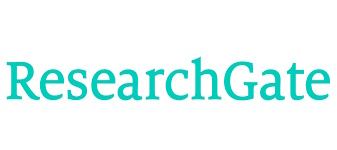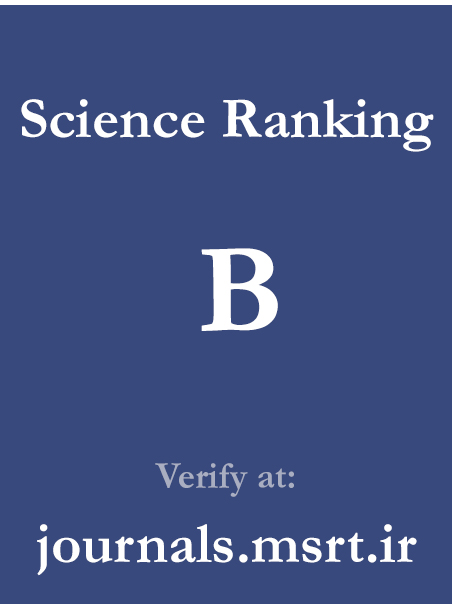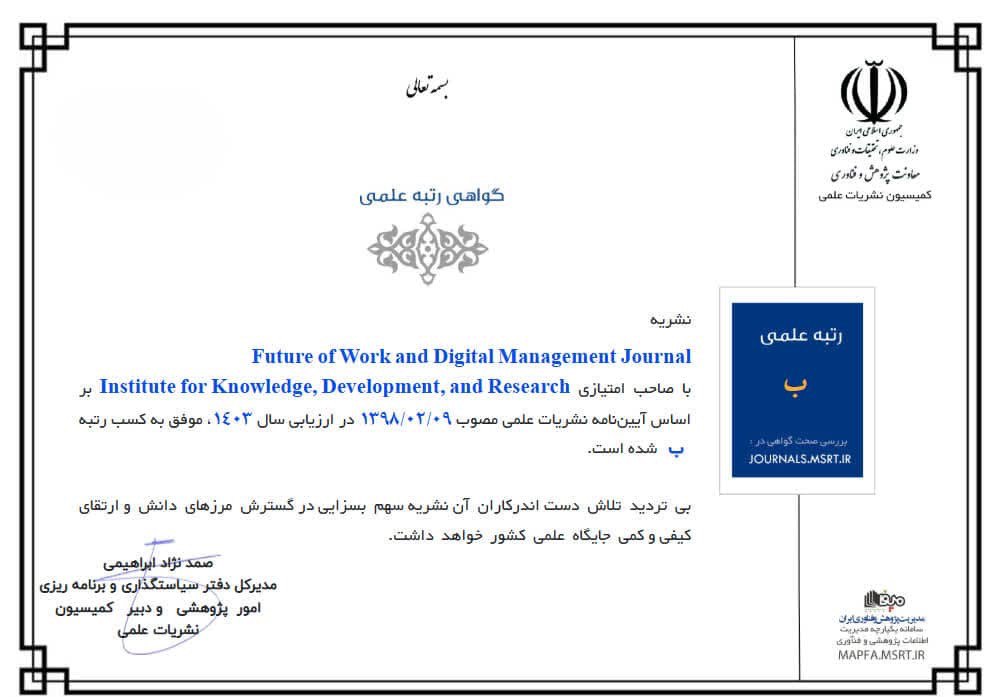Futures Studies on the Evaluation of Humanitarian Marketing Functions: Perspectives on the Development of Green Products
Keywords:
Humanitarian Marketing, Green Product Development, Scenario PlanningAbstract
Marketing strategies in the contemporary era, beyond technological innovations and product competitiveness in market offerings, are increasingly grounded in humanitarian approaches due to growing social sensitivities. These approaches can contribute to the dissemination of widespread social ethics and civic engagement within competitive markets, thereby fostering the path toward achieving environmental sustainability. The purpose of this study is to conduct a foresight-based evaluation of the functions of humanitarian marketing in shaping the development perspectives of green products in the automotive industry. From a methodological standpoint, the research is exploratory in nature and developmental in its intended outcomes. Initially, thematic analysis was employed to identify the core themes of humanitarian marketing functions in the context of green product development. A Delphi analysis was subsequently conducted to examine the reliability of the identified themes. Finally, scenario analysis was used to structure prospective pathways for the development of green products in the automotive industry through humanitarian marketing. In this study, experts in the field of marketing who possessed substantial conceptual and contextual knowledge of humanitarian marketing participated through interview tools and matrix-based checklists. Additionally, in the quantitative phase, 25 managers from active companies in the automotive industry—who had completed training courses on green product development in industrial management—were selected to contribute to the matrix implementation processes. The results of the first phase of the research, obtained from 12 expert interviews, led to the identification of three overarching themes, six organizing themes, and 32 basic themes. The Delphi analysis confirmed that the organizing themes demonstrated sufficient reliability for generalization within the study's context. The second phase of the study, by validating the two key themes—green cognitive value creation in customers and green trust-building among customers—as pivotal axes for constructing plausible scenarios, revealed that four matrices could define the future perspectives for evaluating humanitarian marketing functions in green product development. The findings indicate that Iran’s automotive industry is at an early stage of producing environmentally compatible products. To advance this trajectory, the industry must adopt humanitarian approaches that prioritize the rights of citizens and future-generation customers and pursue emergent marketing strategies in a non-monopolistic market.
Downloads
References
[1] U. K. Ghosh, "Transformative AI Applications in Business Decision-Making," pp. 1-40, 2025, doi: 10.4018/979-8-3373-1687-1.ch001.
[2] G. Gupta, "The Impact of Artificial Intelligence on Modern Program Management," International Journal of Scientific Research in Computer Science Engineering and Information Technology, vol. 11, no. 1, pp. 592-600, 2025, doi: 10.32628/cseit25111266.
[3] F. Keppeler, "How Ensembling AI and Public Managers Improves Decision-Making," Journal of Public Administration Research and Theory, 2025, doi: 10.1093/jopart/muaf009.
[4] C. R. Sauer and P. Burggräf, "Hybrid Intelligence – Systematic Approach and Framework to Determine the Level of Human-Ai Collaboration for Production Management Use Cases," Production Engineering, 2024, doi: 10.1007/s11740-024-01326-7.
[5] P. Pokala, "Artificial Intelligence in SAP S/4hana: Transforming Enterprise Resource Planning Through Intelligent Automation," International Journal of Scientific Research in Computer Science Engineering and Information Technology, vol. 10, no. 6, pp. 191-201, 2024, doi: 10.32628/cseit24106169.
[6] D. K. H. Gopalaswamy, "AI and Human AI Collaboration in Oracle Cloud Technologies for Integration and Process Automation," European Journal of Computer Science and Information Technology, vol. 13, no. 8, pp. 107-128, 2025, doi: 10.37745/ejcsit.2013/vol13n8107128.
[7] J. M. Bradshaw, L. Bunch, M. J. Prietula, E. L. Queen, A. Uszok, and K. B. Venable, "From Bench to Bedside: Implementing AI Ethics as Policies for AI Trustworthiness," Aaai-Ss, vol. 4, no. 1, pp. 102-105, 2024, doi: 10.1609/aaaiss.v4i1.31778.
[8] J. Żywiołek, "Trust-Building in AI-Human Partnerships Within Industry 5.0," System Safety Human - Technical Facility - Environment, vol. 6, no. 1, pp. 89-98, 2024, doi: 10.2478/czoto-2024-0011.
[9] N. K. D. Gowda, "AI and Human-Ai Collaboration in Financial Reconciliation Systems," International Journal of Scientific Research in Computer Science Engineering and Information Technology, vol. 11, no. 1, pp. 3255-3265, 2025, doi: 10.32628/cseit251112298.
[10] M. Quafafou, "Diversity of Perception in Human-Ai Collaboration," vol. 161, 2025, doi: 10.54941/ahfe1005929.
[11] N. Ameen, M. Pagani, E. Pantano, J. H. Cheah, S. Y. Tarba, and S. Xia, "The Rise of Human–Machine Collaboration: Managers’ Perceptions of Leveraging Artificial Intelligence for Enhanced B2B Service Recovery," British Journal of Management, vol. 36, no. 1, pp. 91-109, 2024, doi: 10.1111/1467-8551.12829.
[12] A. Singh and J. Pandey, "Artificial Intelligence Adoption in Extended HR Ecosystems: Enablers and Barriers. An Abductive Case Research," Frontiers in Psychology, vol. 14, 2024, doi: 10.3389/fpsyg.2023.1339782.
[13] M. Haupt, J. Freidank, and A. Haas, "Consumer Responses to Human-Ai Collaboration at Organizational Frontlines: Strategies to Escape Algorithm Aversion in Content Creation," Review of Managerial Science, vol. 19, no. 2, pp. 377-413, 2024, doi: 10.1007/s11846-024-00748-y.
[14] A. Choubey, "Testing AI Models: The Human Factor in Ensuring Accuracy, Fairness, and Transparency," International Journal of Scientific Research in Computer Science Engineering and Information Technology, vol. 11, no. 1, pp. 2237-2245, 2025, doi: 10.32628/cseit251112238.
[15] E. A. Hassan and A. M. El‐Ashry, "Leading With AI in Critical Care Nursing: Challenges, Opportunities, and the Human Factor," BMC Nursing, vol. 23, no. 1, 2024, doi: 10.1186/s12912-024-02363-4.
[16] J. Liu, W. T. Yue, A. C. M. Leung, and X. Zhang, "Find the Good. Seek the Unity: A Hidden Markov Model of Human-Ai Delegation Dynamics," Mis Quarterly, 2024, doi: 10.25300/misq/2024/18232.
[17] A. Masnun, "Optimizing Human-Ai Collaboration in Educational Administration in Muara Bungo, Jambi: An HRD Framework for Role Redefinition, Skill Development, and Change Management," Edu, vol. 2, no. 2, pp. 114-125, 2024, doi: 10.61996/edu.v2i2.85.
[18] H. Asaad, S. Askar, A. Kakamin, and N. Faiq, "Exploring the Impact of Artificial Intelligence on Humanrobot Cooperation in the Context of Industry 4.0," Applied Computer Science, vol. 20, no. 2, pp. 138-156, 2024, doi: 10.35784/acs-2024-21.
[19] D. Mariyono and A. N. A. Hidayatullah, "People, Machines, Enterprises and AI Unite for Impactful Change," Journal of Ecohumanism, vol. 3, no. 3, pp. 1158-1176, 2024, doi: 10.62754/joe.v3i3.3438.
[20] A. Atolagbe-Olaoye, "Collaborative Information Behavior and Human-Ai Context in Group Work," International Journal of Library and Information Services, vol. 13, no. 1, pp. 1-16, 2025, doi: 10.4018/ijlis.366590.
[21] J. Park, R. D. Ellezhuthil, P. Wiśniewski, and V. K. Singh, "Collaborative Human-Ai Risk Annotation: Co-Annotating Online Incivility With CHAIRA," Information Research an International Electronic Journal, vol. 30, no. iConf, pp. 992-1008, 2025, doi: 10.47989/ir30iconf47146.
[22] C. Costa and S. Ghosh, "Empowering Customer Service With Generative AI: Enhancing Agent Performance While Navigating Challenges," Information Research an International Electronic Journal, vol. 30, no. iConf, pp. 150-158, 2025, doi: 10.47989/ir30iconf47566.
[23] D. Katsiuba, "Joining Forces for Online Feedback Management: Policy Recommendations for Human–AI Collaboration," Data & Policy, vol. 7, 2025, doi: 10.1017/dap.2025.13.
[24] A. Stenhouse et al., "A Vision of Human–AI Collaboration for Enhanced Biological Collection Curation and Research," Bioscience, 2025, doi: 10.1093/biosci/biaf021.
Downloads
Published
Submitted
Revised
Accepted
Issue
Section
License

This work is licensed under a Creative Commons Attribution-NonCommercial 4.0 International License.








